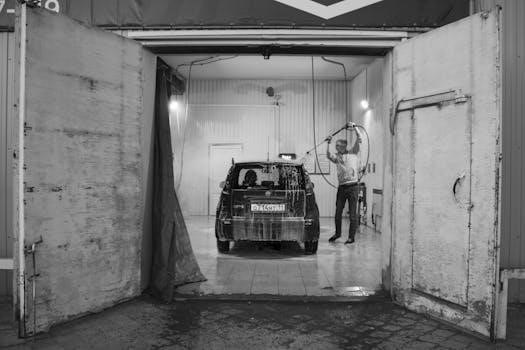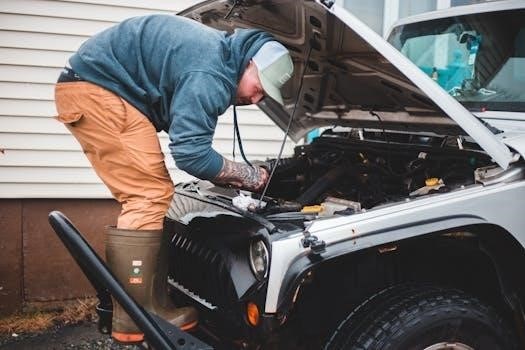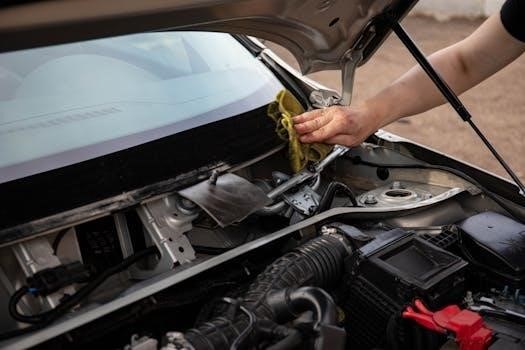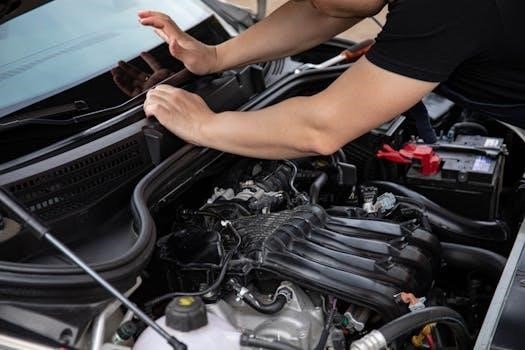Common Chamberlain Opener Problems
Many Chamberlain garage door openers experience issues like the door not moving at all, or only partially․ Sometimes, the motor might run, but the door remains still․ Remote controls and keypads can also fail to work, causing frustration and inconvenience․
Door Doesn’t Open or Close
A common frustration with Chamberlain garage door openers is when the door refuses to open or close․ This issue often stems from a variety of underlying problems․ The most straightforward cause to investigate is the power supply․ Ensure the opener is properly plugged into a functioning outlet and that the circuit breaker hasn’t tripped․ Another possibility is that the safety sensors, located near the bottom of the door track, might be misaligned or obstructed․ These sensors are crucial for safety and prevent the door from closing if something is in its path․ If these sensors are not working correctly, the opener will stop functioning․ Additionally, check if there are any obstructions in the door’s path․ This could be something as simple as a misplaced object or a build-up of debris on the tracks․ Finally, the door springs might be broken or have lost their tension, making it impossible for the opener to move the door․ It is very important to check these parts of the system to ensure correct functioning․
Door Only Opens Partially
Another common issue with Chamberlain garage door openers is when the door only opens partially, stopping before reaching its fully open position․ This behavior can be caused by several factors that require careful investigation․ Often, the travel limits set within the opener might be improperly adjusted․ These limits tell the opener how far the door should travel both when opening and closing․ If these settings are wrong, the door will stop prematurely․ It’s also possible that the door is encountering an obstruction along its path, preventing it from moving fully․ Carefully check the tracks for any debris or objects that might be blocking the door’s movement․ The door springs can also cause this problem if they are not working properly․ The springs provide the necessary tension to help lift the door, and if they are weak or broken, the door may not have the power to reach its full open position․ It is important to also check the safety sensors to ensure that they are not triggering an obstruction․
Opener Makes Noise but Door Doesn’t Move
A frustrating situation with a Chamberlain garage door opener is when the motor operates, producing its usual sounds, but the garage door itself remains stationary․ This often indicates a problem in the mechanical connection between the motor and the door itself․ The first thing to check is the drive mechanism, such as the belt or chain, which transfers the power from the motor to the door․ If this is broken or has slipped, the opener motor may run, but the door will not move․ The gears inside the opener unit can also be a source of this problem․ If these gears are stripped or damaged, they may spin but not effectively engage the drive mechanism, leading to a lack of movement․ Another possibility is that there is a significant obstruction preventing the door from moving․ This is why it is always important to check for obstructions on the tracks and to test the door manually to see if it moves easily․

Remote Control Not Working
When a Chamberlain garage door opener’s remote control stops working, it can be a significant inconvenience․ Before assuming the worst, there are several troubleshooting steps to consider․ A common cause is weak or dead batteries in the remote itself․ Replacing the batteries is a quick first step․ If this doesn’t solve the problem, check for any obstructions between the remote and the opener unit, as sometimes interference can block the signal․ Additionally, make sure that the remote is programmed correctly with the opener․ It is possible that the remote lost its pairing and needs to be reprogrammed by following the instructions in your Chamberlain manual․ If you are still facing difficulties, it is also worth checking that there are no issues with the opener’s internal receiver․ The receiver may need to be reset or checked by a professional․ If you are using a new remote control, make sure it is compatible with your specific Chamberlain model․
Keypad Not Working
A non-functional keypad on a Chamberlain garage door opener can be just as frustrating as a faulty remote․ Start troubleshooting by checking the keypad’s batteries, as they are often the culprit․ Replace them with fresh ones to see if that restores functionality․ If battery replacement doesn’t resolve the issue, ensure the keypad is properly programmed to communicate with the opener unit․ Sometimes, the keypad may lose its programming and require re-pairing․ Consult your Chamberlain manual for specific instructions on how to reprogram your model․ Look for any physical damage or loose connections on the keypad itself․ If the keypad is exposed to harsh weather conditions, it can sometimes affect its performance․ In addition, make sure the keypad is within the operating range of the opener, as distance may cause connection issues․ Check your opener’s receiver to rule out any malfunctions there․ If all else fails, professional assistance might be necessary․

Troubleshooting Steps
When your Chamberlain garage door opener malfunctions, a systematic approach is key․ Check the power, inspect safety sensors, and examine door springs first․ Test the remote batteries, look for track obstructions, and reprogram devices if needed;
Check Power Supply
A crucial first step in troubleshooting your Chamberlain garage door opener is to verify that it’s receiving adequate power․ Begin by ensuring that the opener is properly plugged into a functioning electrical outlet․ Test the outlet with another device to confirm it is supplying power․ If the outlet is working, check the circuit breaker associated with the garage door opener; a tripped breaker will cut power to the system․ Reset the breaker if it has tripped․ Examine the power cord for any visible damage such as cuts or fraying; a damaged cord could be the cause of power interruptions․ Consider if a recent power outage or surge may have impacted the opener․ If the power supply seems consistent, but the opener remains unresponsive, you should explore other potential problems․ Always ensure the power is disconnected before making any physical inspections․ After ensuring basic power requirements are met, move on to investigate other potential causes for the malfunction of the opener․ If all power related issues have been ruled out, then other components of the system should be examined․
Inspect Safety Sensors
The safety sensors near the base of your garage door are vital for safe operation and are often the cause of malfunctions․ These sensors, which are typically two small units mounted on either side of the door, use an infrared beam to detect obstructions․ Start by ensuring that the sensor lenses are clean and free of dirt or debris․ Misalignment of the sensors can prevent the door from closing correctly, so check to see if they are aligned correctly with each other․ If one sensor is not lit or both sensors are blinking or off, it means that the beam is not aligned․ Check to make sure there is nothing blocking the beam between the two sensors․ If you see an obstruction, remove it․ A common cause is that wires connected to the sensors can become loose or damaged․ Inspect all wiring associated with the sensors, check for any disconnections, and ensure the wiring is securely connected․ If the sensors are still not working after cleaning and aligning, consider checking the wires for continuity and replace the sensors if necessary․ Proper function of the safety sensors is important for the correct and safe operation of your garage door․
Examine the Door Springs
The springs on your garage door play a critical role in its smooth and balanced operation․ These springs, which are usually torsion springs located above the door or extension springs along the sides, counteract the weight of the door, making it easier for the opener to lift․ A common issue arises when these springs are damaged, broken, or have lost tension․ It is important to visually examine the springs for any signs of damage, such as gaps, breaks, or excessive rust․ If you have torsion springs, look for any separations in the spring coils․ If you have extension springs, watch for any stretching or separation at the ends of the spring․ If any damage is noticed, the springs will need to be replaced by a professional․ A door with a damaged or broken spring can be dangerous to handle, and it may cause additional stress on the garage door opener․ Also, be sure that the door is balanced correctly, as it should stay in place when opened at any height․ If the door is too heavy or too light, this can cause problems for the opener and indicate an issue with the springs․
Test the Remote Control Batteries
One of the most common reasons for a garage door remote control to stop working is that the batteries are dead or low․ The remote controls use small batteries, often button cells, that may need to be replaced from time to time․ Before you assume that there is a more significant problem with your garage door opener or the remote itself, it is best to check and replace the batteries․ Start by opening the battery compartment on the back of the remote control, which usually involves sliding or removing a small cover․ Take note of the battery type and polarity (+ and -) as you remove the old batteries, then replace with new ones of the correct type, making sure they are inserted correctly․ After replacing the batteries, test the remote to see if it now operates your garage door․ If it still fails to work, or if the remote’s indicator light is weak or doesn’t illuminate, you might need to consider other troubleshooting steps․ The remote control’s connection with the garage door opener should also be checked at this point․ Also, it’s a good idea to keep spare batteries readily available, especially if you use your remote on a daily basis․
Check for Obstructions on the Tracks
Garage door tracks need to be free from any obstructions to ensure the door operates smoothly and safely․ If the door is having trouble opening or closing, or if it’s making strange noises, it’s essential to inspect the tracks for anything that might be blocking the rollers․ Look for items like small tools, debris, or even accumulated dirt that could be preventing the door from gliding along the tracks easily․ Sometimes, a simple object or a buildup of grime can cause the door to become misaligned, which puts stress on the opener and could also cause damage․ Carefully examine the tracks on both sides of the door, including the horizontal and vertical sections․ Remove any obstructions you find and try to clean the tracks gently with a brush or a cloth․ Be sure not to use any lubricants that could attract more dirt and grime in the future․ Make sure that the rollers are aligned with the tracks․ A thorough inspection and removal of any blockages may be all that’s needed to resolve your garage door problem․ If the issue persists after checking the tracks, then you might need to look at other troubleshooting steps․

Reprogram the Remote or Keypad
If your Chamberlain garage door opener remote or keypad is not working, reprogramming it may be the solution․ Sometimes, the connection between the opener and the remote/keypad can be lost, causing them to fail to communicate․ This can happen due to various reasons, including low batteries, power surges, or accidental interference with the opener’s settings․ To reprogram, start by locating the “learn” button on the garage door opener motor unit․ This button is often located on the back or side of the unit․ Once you find it, press and release it․ Then, within 30 seconds, press the button on your remote or keypad․ The opener should respond in some way, such as the lights flashing or the door moving slightly․ If this doesn’t happen, you may need to try the process again․ If the remote or keypad still does not work, check if the batteries are in good condition․ You should also refer to the owner’s manual for specific instructions on your Chamberlain model․ Reprogramming is a simple step that can restore the functionality of your remote or keypad and save you the expense of replacing them․
Consult the Chamberlain Manual
When troubleshooting your Chamberlain garage door opener, the owner’s manual is an invaluable resource that should not be overlooked․ This manual contains detailed information specific to your model, including troubleshooting steps, error codes, and safety guidelines․ Before attempting any repairs or adjustments, it is crucial to consult the manual for the correct procedure․ It provides step-by-step instructions for common issues, such as programming remotes, adjusting limits, and understanding error codes․ The manual may also contain diagrams and illustrations to help you identify parts and components of your opener․ Ignoring the manual could lead to incorrect repairs or damage to the opener․ If you have misplaced your physical manual, you can often find a digital copy on the Chamberlain website․ The manual is designed to guide you through potential issues and is your first point of reference when something goes wrong․ It can save time and prevent unnecessary frustration by providing clear and accurate information․

